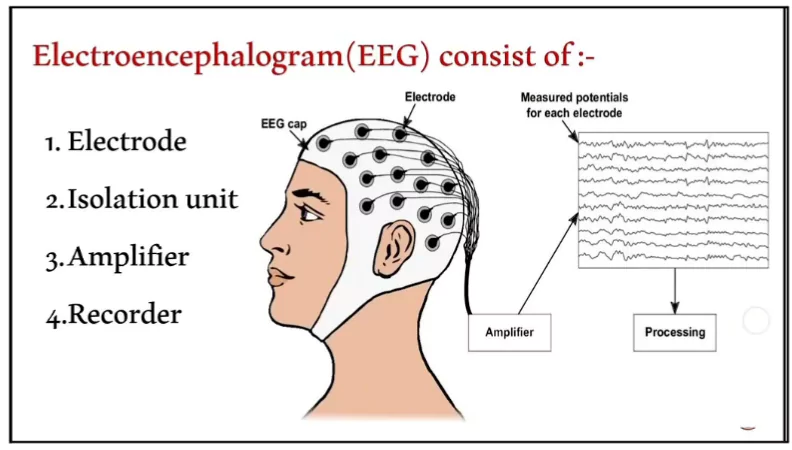This year marks 100 years of electroencephalography (EEG) in human medicine.
What is Electroencephalography (EEG)?

- EEG stands for electroencephalography.
- It measures electrical activity in the brain by tracking the movement of electrically charged particles (ions).
- It measures voltage changes (in microvolts) and the frequency of variations (in hertz).
-
Applications
-
- Diagnosing epilepsy
- Monitoring anaesthesia effects
- Studying sleep patterns
- Assessing neurological activity during a coma
- Confirming brain death
Enroll now for UPSC Online Course
How Does an EEG Test Work?
- Process: During an EEG test, electrodes are placed on the scalp.
- Electrodes placed on the scalp detect voltage changes caused by neuronal activity.
- Path of Electrical Activity: Neuronal electrical activity travels through skin, fluid, and bone layers, undergoing reflection, refraction, and scattering.
- Distance Factor: Electrical activity originates in one location but is detected by electrodes at a distance.
- These changes are recorded and displayed as an electroencephalogram.
- Electrode Placement: The International 10-20 System is used for standardized electrode placement on the head.
- Electrodes are placed based on distances. The space between two neighboring electrodes is either 10% or 20% of the total distance between two specific points on the head.
History of EEG Development
- 1875: British physician Richard Caton detected electrical activity in monkey and rabbit brains.
- 1890: Polish scientist Adolf Beck observed fluctuating brain activity in dogs and rabbits.
- 1912: Vladimir Pravdich-Neminsky recorded the first mammalian EEG in a dog’s brain.
- 1924: Hans Berger recorded the first human EEG, named it, and demonstrated its clinical use.
Advantages of Electroencephalography (EEG)
- Non-invasive and painless procedure: EEG uses electrodes placed on the scalp to record electrical activity in the brain.
- There is no need to break open the skull and it is a painless procedure.
- Wide range of applications: EEG is used in diagnosing various conditions including epilepsy, sleep disorders, head injury, and brain tumors.
- It is also used to assess brain death and the effects of anesthesia.
- Relatively simple and cost-effective: EEG equipment is relatively inexpensive and doesn’t require a lot of space. The test is portable and doesn’t use radiation.
- Measures rapid electrical activity: EEG is effective in tracking electrical activity in the brain happening in milliseconds.
- Better than other diagnostic tools for specific purposes: EEG is the best available test to diagnose epilepsy.
- Portable: EEG can be performed in various settings, not just in hospitals.
Check Out UPSC NCERT Textbooks From PW Store
Disadvantages of Electroencephalography (EEG)
- Low spatial resolution: EEG measures electrical activity on the scalp surface which makes it difficult to pinpoint the exact location of the activity within the brain.
- It is biased towards electrical signals generated closer to the surface of the cortex.
- Difficulty in interpreting data: EEG readings can be affected by volume conduction, which is the movement of electrical activity through the head.
- Other physiological activities, such as blinking or muscle movement, can also create noise in the data.
- Limited ability to detect deep brain activity: EEG is more sensitive to electrical signals generated by the brain’s surface than those generated by deeper structures.
- Problem of thick hair and Time consuming: Thick hair can interfere with the EEG signal.
- The test requires applying gel and precisely placing electrodes on the scalp, which can be time-consuming.
Volume Conduction
It refers to the movement of electrical activity generated by neurons through various layers of the head (skin, fluid, bone) to reach the electrodes placed on the scalp. |
![]() 16 Jul 2024
16 Jul 2024

